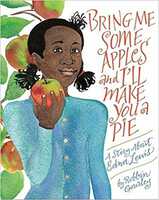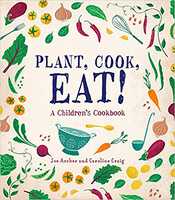Literary
Bring me some apples and I'll make you a pie: A story about Edna Lewis

This picture book describes the childhood of famous chef Edna Lewis which was grounded in the seasonal production of fruits and vegetables of the farm and garden. With vivid language, this book recalls the sensory nature of seasons, and uses rhymes and poetry to educate about roots, bees, favorite recipes. A window into the past of an active family farm, this story illustrates what is used to be like to live off the land and provides a clear picture of seasonal harvests of fruit and vegetables. Recipes are included in the back as well as a brief biography of Chef Lewis and a list of her cookbooks.
Educator notes:
Informational
Plant, cook, eat!: A children's cookbook

This book is an excellent beginning resource on gardening, cooking and enjoying fresh from the farm vegetables. Easy to follow text gives instructions on preparing soil, including compost amendments, sowing and planting, and detail problem areas and garden pests. The inclusion of vegetable recipes gives the opportunity for full implementation of the garden to table concept and serves to not only provide for additional participation, but also for a complete understanding of the cycle of food and food literacy.
Educator notes:
Topic: Food literacy, cooking, farm to table movement
Age: Primary (K-3)
Active Learning Strategy: K-W-L Charts
Type: Whole Group Exercise Title: Garden to Table Harvest
Learning Objectives: The student will:
Description: This unit on food literacy can begin with children collectively creating a Know/Wonder/Learn chart about a selection of fruits and vegetables. This chart should be discussed and added to before and after reading and exploring the paired texts and after participation in or demonstration of food preparation, such as salad, applesauce, pie or even sweet bread like zucchini or pumpkin. I highly recommend using seasonal fruits and vegetables which not only benefits student comprehension of the seasonality of food, but also allows for the flexibility to repeat activity at different times of the year.
Materials:
Guided and Independent Practice: Lead discussion involving comparison of vegetables and fruits and methods of food preparation. Discuss the differences between raw and cooked and the changes produced by cooking. Allow children to talk about what plants they are familiar with and what experiences they have had in the garden. This activity can be more or less participatory depending on age of students and available materials and equipment. Colored printables, magazine or other colored pictures could be used to create a bulletin board or mural display. Allow the children to discuss and explain what they have seen and eaten, where they saw and obtained it, and what they now know is required to produce individual foods.
Sharing/Reflection/Closing: This activity can be adapted in so many different ways and both of these texts have such a wide variety of fruit and vegetable dishes that you may choose the best fit for you and your participants. As part of a larger curriculum about agricultural, food and health literacy, this activity can wonderfully engage children in the farm/garden to table movement and introduce fresh healthy eating habits. The sensory portion is key, in my opinion, to connect children with the actual process of harvesting and preparing food such as applesauce or a fruit pie. Participation in a garden visit or active planting or harvesting demonstration would reinforce and enhance the instruction. |
